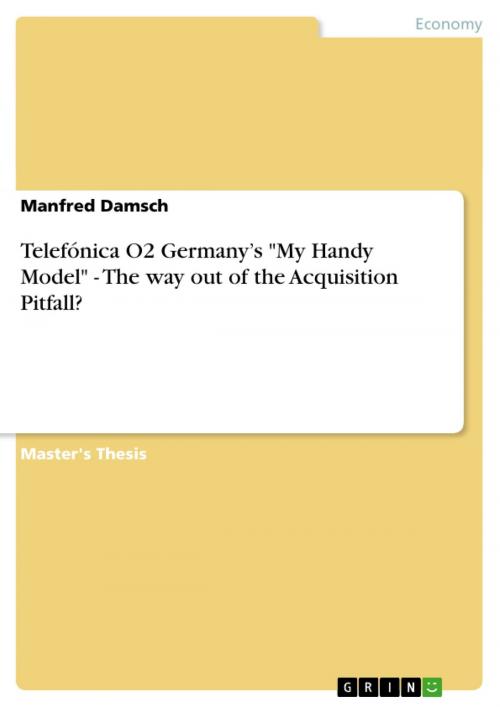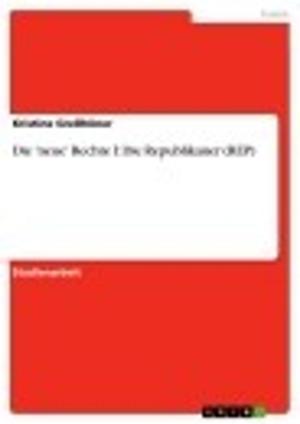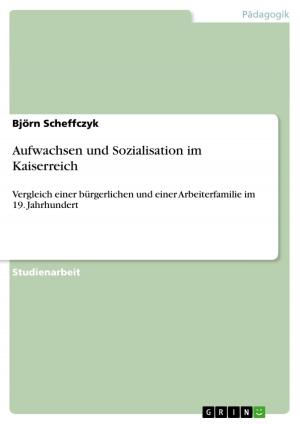Telefónica O2 Germany's 'My Handy Model' - The way out of the Acquisition Pitfall?
Business & Finance, Marketing & Sales| Author: | Manfred Damsch | ISBN: | 9783640950904 |
| Publisher: | GRIN Verlag | Publication: | July 5, 2011 |
| Imprint: | GRIN Verlag | Language: | English |
| Author: | Manfred Damsch |
| ISBN: | 9783640950904 |
| Publisher: | GRIN Verlag |
| Publication: | July 5, 2011 |
| Imprint: | GRIN Verlag |
| Language: | English |
Master's Thesis from the year 2010 in the subject Business economics - Marketing, Corporate Communication, CRM, Market Research, Social Media, grade: 1,3, University of applied sciences, Munich, language: English, abstract: From the beginning of the German Digital Mobile Telecommunication Market in the early 1990s until today, competition between the 2 to 4 main Mobile Network Operators (MNO) was and is driven by gaining customers without any limitation of acquisition costs per customer. The so-called SAC (Subscriber Acquisition Costs) reached unforeseen heights over time and has become an indispensable incentive measure for sales and consumer. The outstanding, extraordinary service to initiate and receive phone calls at every time and every place, became more and more attractive and affordable to almost everybody who was willing to pay for this new kind of civilian freedom. In a consequence of the unregulated mobile telecommunication service market at that time, service charges where solely determined by competition between rare touting providers in a strong and seemingly endless expanding market. The customer acquisition model, in which mobile phones with a market value of more than 200 Euro are offered for a symbolic price of 1 Euro, paid and partly still pays off for MNO and Service Provider. The payback period for SAC payments was limited to 3-9 month after contract formation, while the contract continues to run for further 15-21 month with guaranteed monthly minimum turnover. With the foundation of the 'Regulierungsbehörde für Telekommunikation und Post (RegTP) ' in 1998 and rising competition in an increasingly saturated market, the service charges achievable per month and customer have decreased year by year. Even today in an already oversaturated German Telecommunication Market, the minimum of average revenue to be generated per contract still has not been reached. MNO, Service Provider and finally the customers have to change their thinking about acquisition models and price sensitivity for mobile phones. The end of the mobile phone subsidy is about to happen but what comes next? The present Thesis is about the revolutionary approach of Telefónica O2 Germany to change the market and customer expectations by introducing the so-called 'My Handy' mobile phone payment concept. Background analysis for the need of change, approaches to go, pitfalls to be avoided and obstacles to take will be part of this thesis. Finally the expected and realized impact on Telefónica O2 Germany's business and an outlook to future evolutions of the German Mobile Communication Market will generically be discussed.
Master's Thesis from the year 2010 in the subject Business economics - Marketing, Corporate Communication, CRM, Market Research, Social Media, grade: 1,3, University of applied sciences, Munich, language: English, abstract: From the beginning of the German Digital Mobile Telecommunication Market in the early 1990s until today, competition between the 2 to 4 main Mobile Network Operators (MNO) was and is driven by gaining customers without any limitation of acquisition costs per customer. The so-called SAC (Subscriber Acquisition Costs) reached unforeseen heights over time and has become an indispensable incentive measure for sales and consumer. The outstanding, extraordinary service to initiate and receive phone calls at every time and every place, became more and more attractive and affordable to almost everybody who was willing to pay for this new kind of civilian freedom. In a consequence of the unregulated mobile telecommunication service market at that time, service charges where solely determined by competition between rare touting providers in a strong and seemingly endless expanding market. The customer acquisition model, in which mobile phones with a market value of more than 200 Euro are offered for a symbolic price of 1 Euro, paid and partly still pays off for MNO and Service Provider. The payback period for SAC payments was limited to 3-9 month after contract formation, while the contract continues to run for further 15-21 month with guaranteed monthly minimum turnover. With the foundation of the 'Regulierungsbehörde für Telekommunikation und Post (RegTP) ' in 1998 and rising competition in an increasingly saturated market, the service charges achievable per month and customer have decreased year by year. Even today in an already oversaturated German Telecommunication Market, the minimum of average revenue to be generated per contract still has not been reached. MNO, Service Provider and finally the customers have to change their thinking about acquisition models and price sensitivity for mobile phones. The end of the mobile phone subsidy is about to happen but what comes next? The present Thesis is about the revolutionary approach of Telefónica O2 Germany to change the market and customer expectations by introducing the so-called 'My Handy' mobile phone payment concept. Background analysis for the need of change, approaches to go, pitfalls to be avoided and obstacles to take will be part of this thesis. Finally the expected and realized impact on Telefónica O2 Germany's business and an outlook to future evolutions of the German Mobile Communication Market will generically be discussed.















